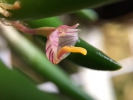|
|
|
|
|
| |
Flasks of
Dendrobium prenticei 'MC4591' × self |
|
| |
|
|
| |
| Number: |
TN8273 |
| Name: |
Dendrobium prenticei 'MC4591' × self
|
| Type: |
self (What's that?) |
|
Seed Donor: |
Troy C. Meyers
|
|
Click to Enlarge

Pod Parent Flower |
Click to Enlarge

Pod Parent Flower |
Click to Enlarge

Pod Parent Plant |
|
|
|
| |
Comments: Parent plant: One of the offspring from our TN3418 effort of 2002.
For additional origin/habitat information supplied courtesy of
Charles and Margaret Baker, see further below, near the bottom of this page.
|
Temperatures we attempt to use in the lab & greenhouse:
| For Species: |
|
Spring, Summer, Autumn: days average 83°F, nights 67°F; best fit is warm-intermediate 87-64°F
(Source:
Baker's Web OSC) |
| For Species: |
|
Winter: days average 74°F, nights 56°F; best fit is cool-intermediate 75-58°F
(Source:
Baker's Web OSC) |
|
About the name...
| Etymology of |
Dendrobium |
|
From Greek "dendron" tree and "bios" life.
(Source:
Pridgeon 1992) |
| Etymology of |
prenticei |
|
Named for Dr. Ch. Prentice, Australian botanist.
(Source:
Mayr & Schmucker 1998) |
| Pronunciation of |
Dendrobium |
|
den-DRO-bee-um
(Source:
Pridgeon 1992) |
|
If you would like to direct someone to this web page, please copy and paste this URL into your email:
http://troymeyers.com/d?018273
| Ordering Information |
| You are not currently logged in. |
|
You must be a registered user and be logged in to reserve a flask or place a notification request. Please log in:
|
|
|
|
|
|
| |
The origin/habitat information below is supplied courtesy of Charles and Margaret Baker
The following information is based on the name of the plant provided by the donor, and assumes that the name is correct. If the plant has been misidentified, then the following information may not be correct.
This text is copyrighted by the Bakers and may not be reproduced without permission.
ORIGIN/HABITAT: Northeastern Australia. The habitat extends from the
Burdekin River northward to the Annan River. Plants grow from near sea
level to moderately high elevations. They are usually found in high light,
often on the outer branches of rainforest trees, on moss-covered branches
overhanging creeks, or on trees or rocks in moderately open forests.
More about this information and the Bakers...
|
|
|
| |
|
|
|